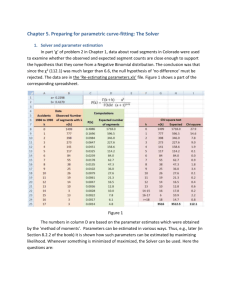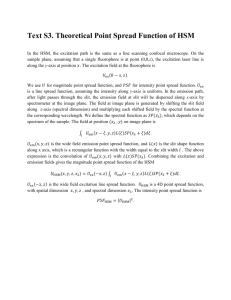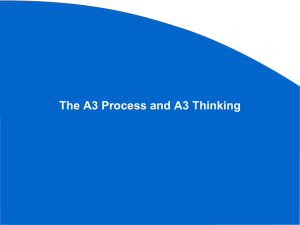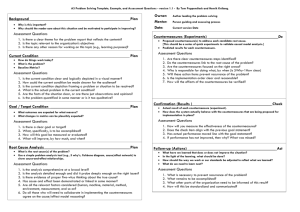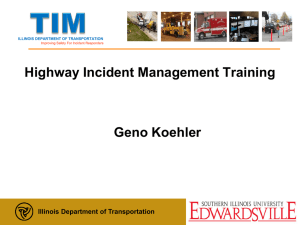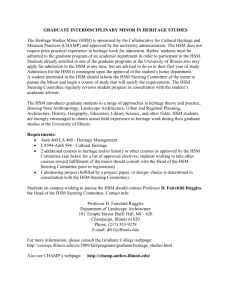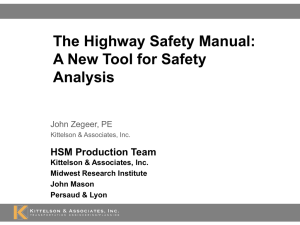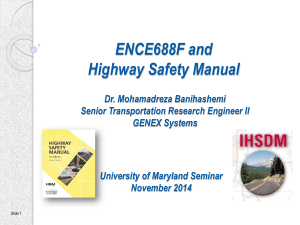Evaluation of Illinois Highway Safety Programs: Six Years
advertisement
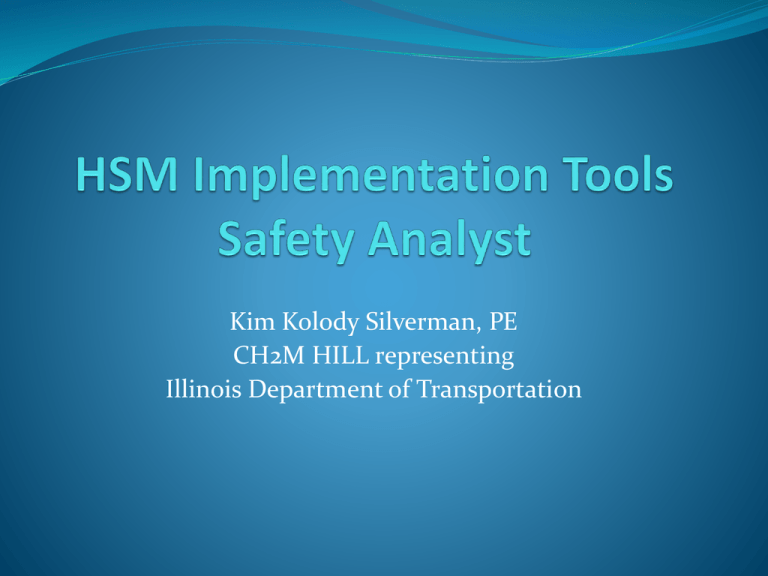
Kim Kolody Silverman, PE CH2M HILL representing Illinois Department of Transportation We commonly trade safety off against something else Environment Safety HSM Tools Safety Impacts • Traffic Noise Model 1.0 • CAL3QHC • Mobile 5a • 3-D Visualization • CITYGREEN Environmental Impacts • • • • • •Construction HCM Plans CORSIM •Cost Models PASSER TRANSYT7F •Real estate appraisals VISSIM •DOT databases Traffic Operations Right-of-Way Greater weight More quantitative Design Criteria (nominal safety) Costs We’re Interested in Other Impacts for Project Level Decisions – What 3 About Substantive Safety? Part A Introduction Human Factors Fundamentals Part B Roadway Safety Management Process Part D Crash Modification Factors (CMFs) Part C Predictive Method Tools for Implementing HSM Excel Spreadsheets Interactive Highway Safety Design Model (IHSDM) Safety Analyst HSM Excel Spreadsheets Project level basis Simple, straightforward Limited data required Worksheet 3A -- Predicted and Observed Crashes by Severity and Site Type Using the Site-Specific EB Method (1) Site type (2) (3) (4) (5) (6) (7) (8) Observed Overdispersion Weighted Expected crashes, Parameter, k adjustment, w average crash Nobserved frequency, (crashes/year) Nexpected Predicted average crash frequency (crashes/year) N predicted N predicted N predicted Equation A-5 from Equation A-4 (TOTAL) (FI) (PDO) Part C Appendix from Part C Appendix ROADWAY SEGMENTS Segment 1 6.106 1.960 4.146 10 0.157 0.510 8.0 Segment 2 0.495 0.159 0.336 2 2.360 0.461 1.3 1.000 0.0 0.394 2.9 1.000 0.0 1.000 0.0 -- 12.3 Segment 3 INTERSECTIONS Intersection 1 Intersection 2 2.847 1.181 1.665 3 0.540 Intersection 3 COMBINED (sum of column) 9.448 3.300 6.147 15 -- Interactive Highway Safety Design Model Provides expected safety, operational performance HSM techniques + Modules to compare design to standards Requires detailed data input Free The Vision of SafetyAnalyst – Software Akin to the HCS+ 1 2 3 Definitive; represents quantitative ‘state-ofthe-art’ information Widely accepted within professional practice of transportation engineering Science-based; updated regularly to reflect research Purpose of SafetyAnalyst SafetyAnalyst provides state-of-the-art tools for safety management that provide capabilities beyond those currently available to highway agencies Effectiveness of decision making Efficiency of decision support Intended for those who will: Identify candidate sites for safety improvements Investigate the types of safety improvements needed for specific sites Assess whether specific safety improvements are economically justified and should be programmed Evaluate the safety effectiveness of implemented projects Road Safety Management Process Network Screening Diagnosis & Countermeasure Selection Economic Appraisal & Prioritization Safety Effectiveness Evaluation Module 1 Network Screening Network Screening Review highway network (or any portion of the network) to identify sites with potential for safety improvement Identify sites that are candidates for further investigation 6 different methods for screening Module 2 Diagnosis & Countermeasure Selection Helps to identify accident patterns of interest at specific sites Guides user in the diagnosis of safety problems at specific sites Suggests countermeasures that address identified accident patterns of interest Lets user select appropriate countermeasures Module 3 Economic Appraisal & Prioritization Perform economic analysis of alternative countermeasures for a specific site Perform economic analysis of countermeasures across selected sites Select mix of sites and countermeasures to maximize benefits within a given budget Develop priority ranking of alternative improvements Module 4 – Countermeasure Evaluation Safety Effectiveness Evaluation Conduct before-after evaluations of implemented countermeasures Quantify the safety effectiveness of implemented countermeasures based on: Percent change in accident frequency Change in proportion of target accidents Test Data Input for Illinois Category Test Areas Route Type Number of roadway segments Roadway mileage Number of intersections Number of crashes 3 Counties 1 Township State and Local facilities 28,093 7,471 18,704 118,093 Note: Counties are Champaign, Sagamon, Vermillion and the township is West Chicago Crashes represent 2005 to 2009 fatal, A-injury, B-injury, C-Injury, and PDO Data Process for Illinois 3.5 hours for data import 15 minutes for crash data script 2.5 hours for post processing 15 minutes for calibration Total = 6.5 hours for approximately 5% of total data set Challenges Data input and processing takes some time Requires user training Requires agency support Cost Challenges Data Input and Processing Coordinate multiple data sources, data owners Determining business rules Complete data where not available Data input (SQL vs Oracle) Data set-up process time Network screening process time Benefits Powerful analysis tool Automates HSM procedures Calibrates national default SPFs Screen large amounts of data Provides consistent evaluation and results for decision making Benefits Flexible for user Countermeasures, service life, costs included Automates various economic comparisons Set of tools that allows for a better selection of sites and improved prioritization techniques for decision making to maximize resources to reduce severe crashes Benefits Forces coordination between divisions of the agency Better data More data Understanding of data application across the agency which may influence potential changes in agency business practices HSM Implementation Tool: Recommendations Use HSM Excel Spreadsheets where appropriate Apply IHSDM where appropriate Start preparing Safety Analyst for use HSM Implementation Tool: Safety Analyst Recommendations Determine funding options Start the process of data identification, mapping Start educating staff at central office Engage IT staff HSM Implementation Tool: Safety Analyst Recommendations Start with a small test data set Good team coordination Decision making in data set-up Seek assistance from AASHTO, peers For more information Highway Safety Manual http://www.highwaysafetymanual.org/ Safety Analyst http://www.safetyanalyst.org/ Interactive Highway Safety Design Model http://www.tfhrc.gov/safety/ihsdm/ihsdm.htm Questions Priscilla Tobias, PE State Safety Engineer Illinois Department of Transportation (217) 782-3568 priscilla.tobias@illinois.gov Kim Kolody, PE CH2M HILL (773) 458.2883 Kim.Kolody@ch2m.com kolodyka@illinois.gov
